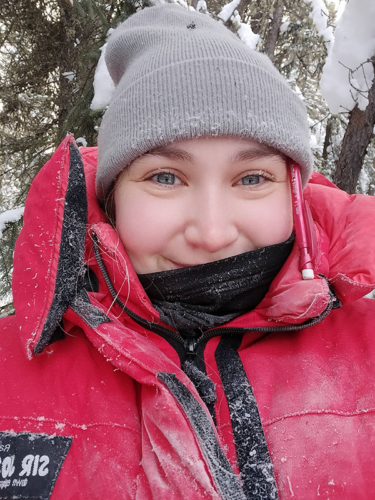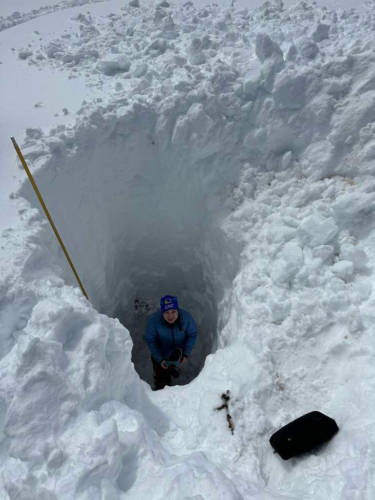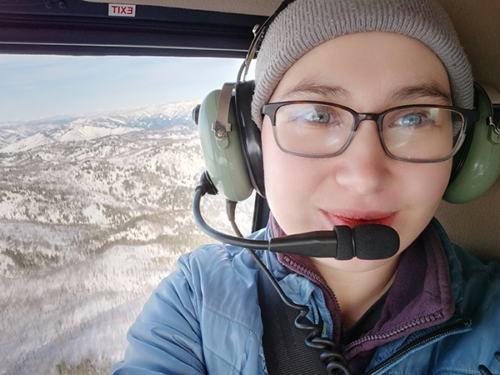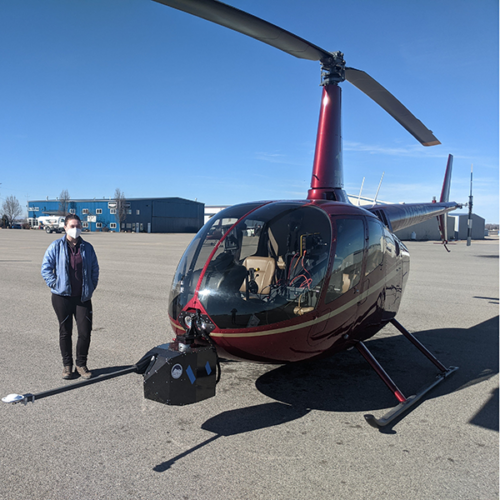
Across the world snow is a critical water resource. In the western United States, seasonal snow accounts for up to 70% of the water supply. From wind-snow interactions to terrain and precipitation patterns, much of today’s snow packs across the world are heavily influenced by climate change.
The National Science Foundation awarded Karina Zikan, a geosciences graduate student in the College of Arts and Sciences, a prestigious Graduate Research Fellowship to support her efforts to develop algorithms to better understand snow depths and snow observation methods for effective water management and hazard mitigation as the climate continues to change.
“My love for snow began early,” Zikan said. “I have skied since I could walk and I was a cross country ski instructor through high school, but it was during my undergraduate years that I combined this personal passion with my academic interests in physics and mathematics.”
Zikan grew up in the Pacific Northwest and has seen firsthand the effects of climate change, from the Olympic Peninsula northwards into Canada and Alaska. She cites her mother and experiences in high school as foundational to her deep love and personal affinity for the environment and studying and protecting the natural world –especially in the face of climate change and warming.
Pathway to Glaciers
Early on, school was frustrating for Zikan as she grew up with dyslexia, but in middle school her first algebra class opened the door to her future in STEM.
“Mathematics was a language I understood and could communicate in easily and was, honestly, just fun,” Zikan said. “I fell in love with math and science and grew to love school.”
She enrolled at St. Olaf College in Minnesota for her undergraduate studies and became an undergraduate researcher in the Ice and Snow Evolution Lab. Under the supervision of Alden Adolph, she was exposed to fieldwork, remote-sensing data, statistical analysis, building sensors and scientific communication focused on the Greenland ice sheet and the Easton Glacier on Mount Baker in Washington state.

“This is what I want to do,” Zikan said. “The coursework for my double mathematics and physics degrees now had a goal: to prepare me to do applied physics research to understand how the cryosphere responds to changes in climate, short-term and long-term.”
Zikan’s time visiting weather stations and climbing mountains strengthened her love for the impact her research could have on water supply, agriculture, transportation and hydroelectric power. She’s presented her research at numerous conferences and meetings, including the American Geophysical Union and Midstates Consortium Science Symposium.
Welcome to the Cryosphere
In 2021, Karina joined the Department of Geosciences, working with Ellyn Enderlin in the Cryosphere Geophysics and Remote Sensing Glaciology Group and continuing to develop her expertise as a researcher in seasonal snow, data science and field work.
In 2018, NASA introduced the ICESat-2 satellite to provide detailed and global light detection and ranging, or lidar, data to study polar ice sheets and sea ice. This method of remote sensing uses pulsed lasers, typically done from airplanes and helicopters, to help generate three-dimensional information of the Earth’s surface. At Boise State, Zikan is developing added algorithms to calculate snow depths using the satellite’s data to better understand watershed impact.
“Karina has been a terrific student,” Assistant Professor Ellyn Enderlin said. “Normally I discourage students from entering a Ph.D. program directly from a bachelor’s degree, but Karina’s intellect, organization, maturity, and dedication to science have made her a terrific Ph.D. student.”

Zikan’s focus at Boise State has been on the Mores Creek summit, an area familiar to locals who frequent the Boise Mountains year-round. As a relatively junior graduate student, she has led a team of researchers using a helicopter-based lidar mapping to produce high resolution snow maps of the Mores Creek summit. By using this remote-sensing technology, Zikan hopes to improve snow depth monitoring and improve understanding of climate modeling, water resource management and hazard mapping.
“Karina is innovative, mature and well organized,” Enderlin said. “She has been one of the student leads for measurements of surface elevations using helicopter-based laser instruments, and I honestly cannot say I would trust very many students with the huge responsibility of performing these surveys.”
Supporting community in STEM
Zikan credits her academic achievements to the support she has received from the community of her peers and mentors allowing her the ability to preserve and thrive as a scientist.
While at St. Olaf College, Zikan created the Women in STEM Honor House becoming the first president her senior year. Along with a close friend, they created an intentional community that supported women in STEM and encouraged the interest and excitement for science.
“As a woman I have, unfortunately, often felt unwelcome or dismissed in STEM environments throughout my academic career,” Zikan said. “Helping make STEM communities more supportive to all is important to me and I enjoy helping lead these efforts.”

At Boise State, Zikan is helping build up the Geosciences Graduate Organization supporting other graduate students in the department, cultivating a department community and providing mentorship and outreach.
“As I work toward my Ph.D. in geophysics, it is important to me to be open about my dyslexia,” Zikan said. “To challenge ideas of what learning disabilities look like and to support younger students with dyslexia and other learning disabilities.”
Her ultimate goal is to further develop multi-sensor integration, like lidar and radar satellites, as a scientific researcher studying the cryosphere and remote sensing. More in depth snow observation is key to developing new snow maps that fully use all available data as climate change continues to alter the Earth.
-by Jamie Fink